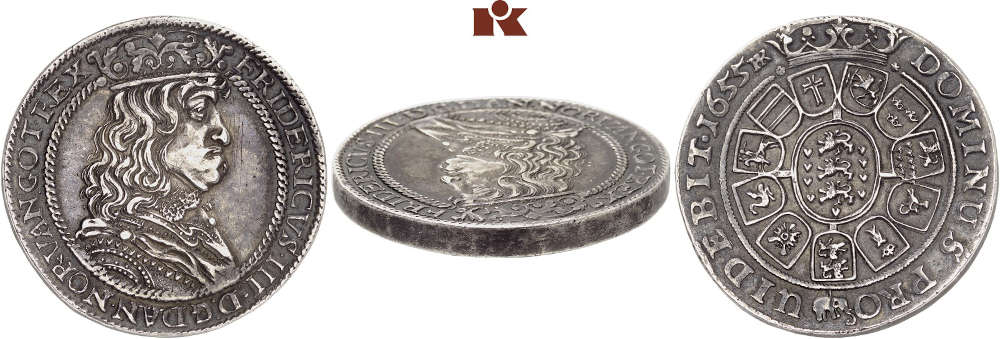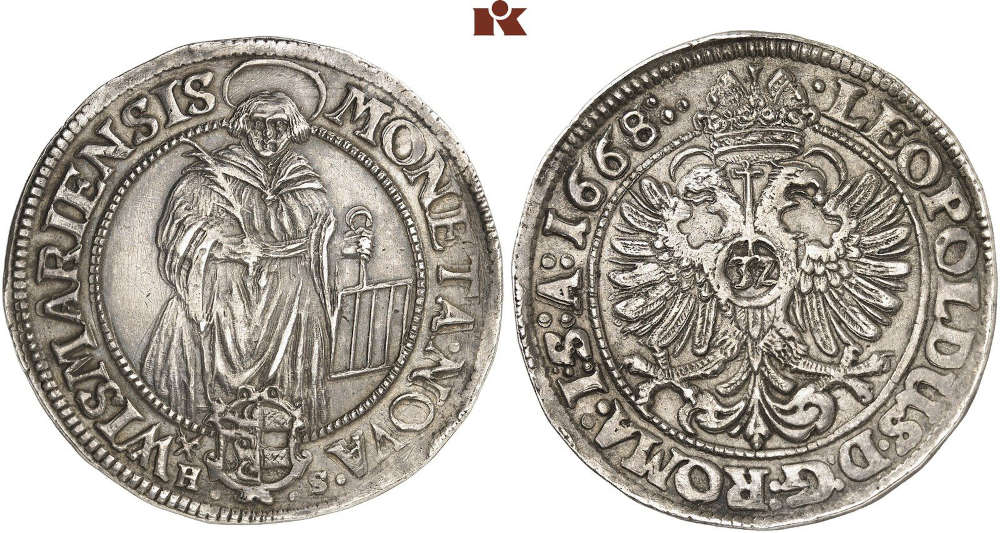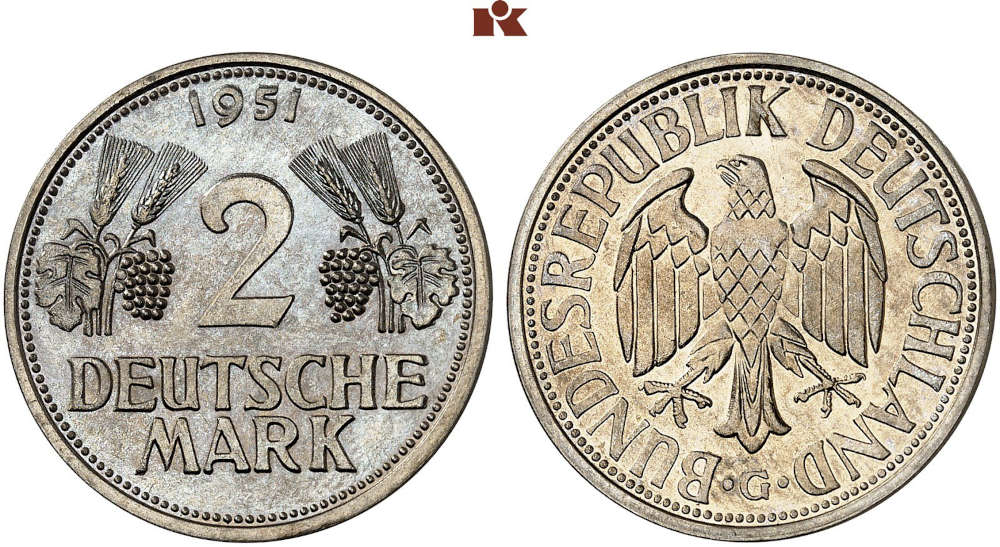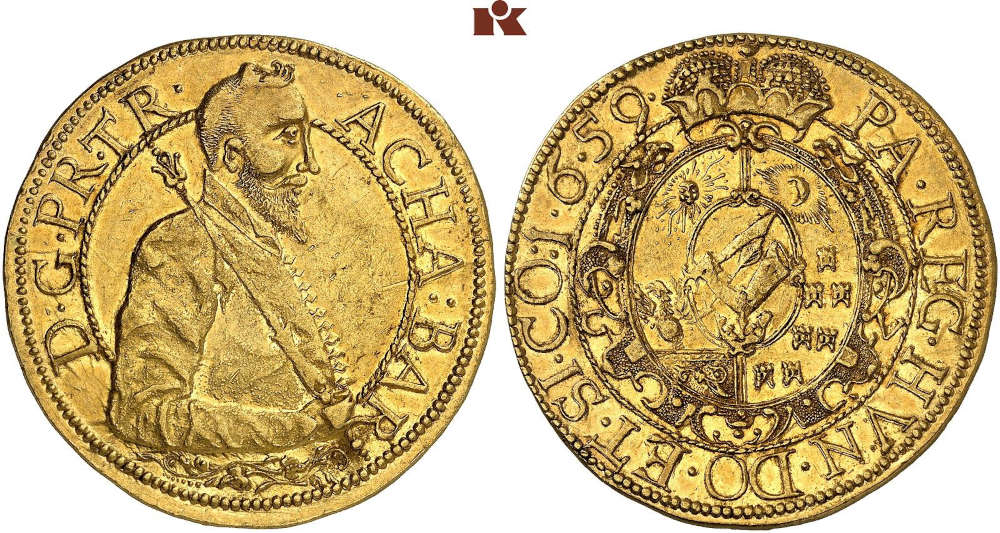Special Collections at Künker in June: Scandinavia, Mainz and 19th-Century Germany
Künker
Auction 408-409
Coins
18-21 June 2024
D-Osnabrück
From 18 to 21 June 2024, Osnabrück will shine in the light of numismatics. Once again, collectors from all over the world have entrusted Künker’s specialists with the sale of the coins that they assembled over many years. This is why several special collections will be auctioned off at once. Particularly extensive are:
- a collection of Scandinavian coins
- a collection of 19th-century German coins
- a collection of Mainz gold coins
In addition, there is a comprehensive ensemble of yield and mining issues from the Preussag AG Collection, a small special collection with Wismar issues as well as a wide range of patterns from the Coenen Collection.
Künker’s auction sales are always a social event. So take the time to participate in the sale on site and enjoy a nice chat with like-minded people during the breaks! Künker’s customer service would be delighted to help you find an accommodation in Osnabrück.
Scandinavian Coins from a Northern European Private Collection
Künker has specialized in coins from Scandinavia for many years. Numerous important collections with a focus on this topic were auctioned off by Künker. In June 2024, the Osnabrück auction house will once again present a major collection of Scandinavian issues. It contains a large series with coins from Denmark and Sweden, but also an extensive ensemble of coins from Schleswig-Holstein.
The time frame of the Danish issues ranges from Hans (1481-1513) to Christian IX (1912-1914); and regarding Sweden from Charles XI (1660-1697) to Charles XV (1859-1872). Connoisseurs will encounter numerous rarities. They include, for example, one of the first gold coins from Denmark and a series of multiple speciedalers, commissioned by Christian IV in 1624. Their Latin inscription bears testimony to the fact that these coins were minted from the silver of the new mines in Kongsberg. It reads Benedictio Domini Divites Facit – and can be roughly translated as: the blessing of the Lord creates wealth without effort.
At least as noteworthy is an extensive series of Danish gold coins. The pieces remind us of a time when Denmark aspired to become a colonial power. Most of the coins are extremely rare. Only 100 specimens of the 1658 Guinea ducat were minted.
German Coins of the 19th Century from a German Private Collection in the Rhenish Region
The 19th century was a period in which monetary treaties and economic power were systematically used to gain political advantage. Without all the monetary and tax treaties, Prussia would have never managed to push Austria out of race to become the dominant German state this quickly after 1848.
Thus, the almost 300 lots with German coins of the 19th century from a German private collection in the Rhenish region are important testimonies to this period of crucial importance for economic history. They contain coins from many parts of the empire – both minted before and after 1871 – as well as Austrian issues.
When selecting his pieces, the collector paid utmost attention to quality, which is why those interested in perfectly preserved early machine-minted pieces can look forward to a rich selection.
Gold Coins from the City of Mainz
Are you a collector of gold coins from the city of Mainz? In this case, you should highlight 21 June 2024 in your calendar. On that very day, an extensive special collection with 90 lots presenting Mainz guldens and ducats will enter the market. The time frame ranges from the early issues of the mid-14th century minted after the Florentine model up to the last ducats created under Friedrich Karl Joseph von Erthal right before the Final Recess of the Imperial Deputation (Reichsdeputationshauptschluss) in 1803. The eventful history of the important archbishopric, which was ruled by some of the most influential politicians of the Middle Ages and the early modern period, is reflected by these coins.
Yield and Mining Issues from the Preussag Collection
Collectors of mining issues – this is for you! Auction 408 includes about 120 lots of excellent provenance. They are all from the Preussag Collection, which was auctioned off between 2015 and 2016 by London Coin Galleries and Künker. Mining fans will encounter interesting motifs on lösers, coins and medals; and numerous pieces bear inscriptions that tell us where the silver they were minted of came from. Those who did not have the opportunity to participate in the sale of the Preussag Collection back then will get a second chance now.
Jacques Taffanel (1875-1946) made a name for himself with his research and his development of safety measures against dust explosions, which frequently occurred in mines. He worked at the state research center in Liévin, which had been set up after the Courrières disaster on 10 March 1906 – with 1,099 casualties, Europe’s worst mining accident to date – to make mining safer. He was awarded this medal in 1911. In the very same year, he received the cross of the Legion of Honor.
Special Collection Wismar
Coins from the city of Wismar are comparatively rare. And well-struck coins from the city of Wismar are even rarer. Therefore, a series of more than 30 lots with coins from Wismar is quite a large offer given this special field. Especially when you consider that these are extraordinarily well-struck pieces of very fine and above quality. Similar selections cannot be found often on the market. So if you collect Wismar issues, you should definitely seize this opportunity.
Patterns from the Coenen Collection
Moreover, another part of the Coenen Collection will be on sale in auction 409. This extensive special collection of German patterns and error coins focuses on pieces minted after 1871. Those who are interested in this field and are looking for special pieces will be delighted about the wide selection of rarities on offer.
For example, the Coenen Collection contains a variety of the Federal German 2-mark piece of 1951, of which only 33 specimens were minted and whose design was never used for mass production. It is almost unbelievable that this lot only has an estimate of 300 euros. Just imagine what such a piece would fetch if we were not talking about a German but a US circulation coin! Currently, prices for German patterns are very low compared to their rarity. Thus, taking a closer look is definitely worth it.
World-Class Rarities
Let us round off this preview with the numerous world rarities that are presented in both Künker auctions 408 and 409. No matter what you collect, you will find a highlight from your field of interest.
Let us begin with a small series of Chinese dollars of excellent quality and great rarity. As many as three lots compete for your attention: a 1916 dollar commemorating the beginning of the Hung Hsien Period, a 1921 dollar for President Xu Shichang’s taking office and a 1924 dollar celebrating the unification of the Republic.
Are you a collector of Belgian coins? In this case, you can choose between a highly rare quadruple souverain d’or of the Spanish King Charles II and a just as rare 100-franc piece of 1853.
Be it a gold medal with the portrait of Oliver Cromwell or a doppio ducato by Alfonso I d’Este – the wealth of outstanding numismatic rarities is downright breathtaking. Let us take Transylvania as an example: there are simple and multiple ducats from Sigismund Rakoczi up to Michael Apafi on offer.
Künker will close this chapter with the three top pieces of the auction sale. Two of them are from France: an eightfold Louis d’or by Louis XIII à la tête laurée from 1640 with an estimate of 200,000 euros; and the pattern for an écu de Calonne by Louis XVI from 1786 with a starting price of 100,000 euros. This probably unique piece was once part of the collection of King Farouk of Egypt.
Those who want to own the 20-kronen piece of Austria’s last emperor of 1918 will get their chance: what is probably the only specimen on the market will be auctioned off at Künker!
Rarities from the German States
Of course, Künker’s catalogs 408 and 409 also include many rarities from the German states.
As usual, Künker showcases particularly valuable pieces in this preview – but the catalogs obviously contain coins from every price category. Estimates start in the mid-three figure range.
If you want to submit your bid from your computer at home, please remember to register for this service in good time.




























